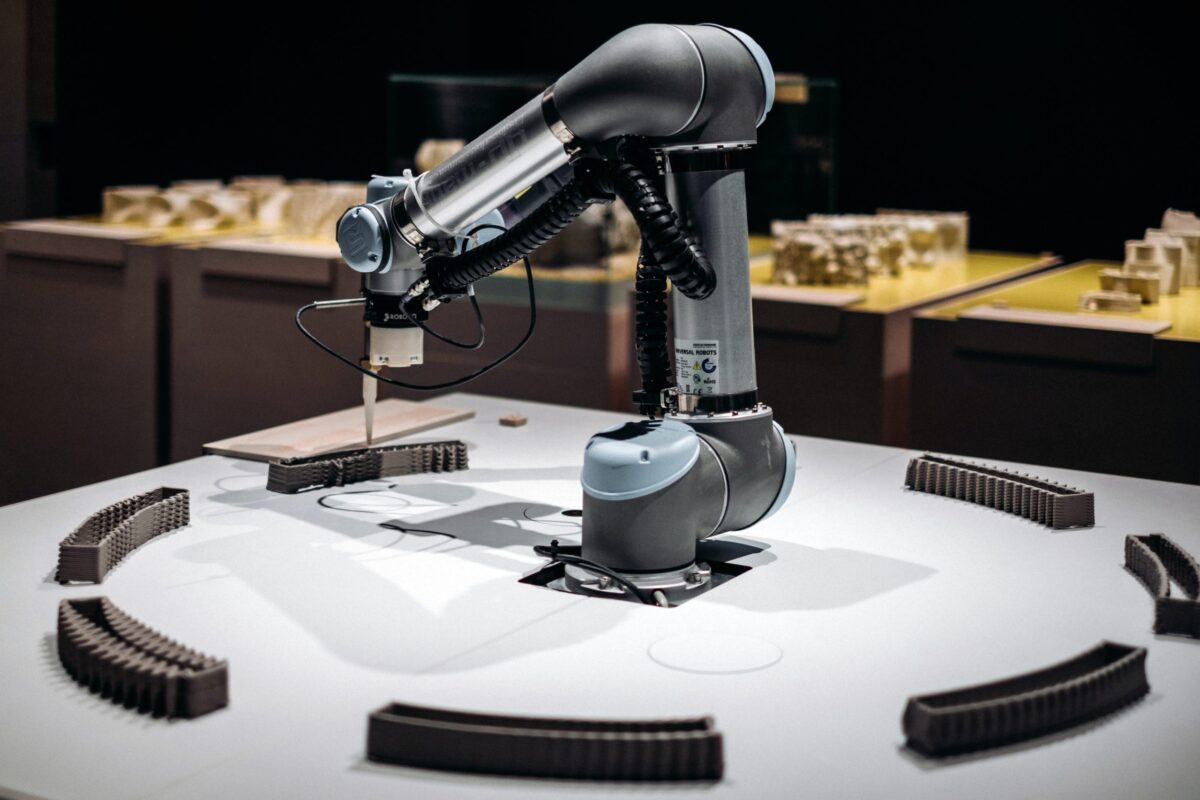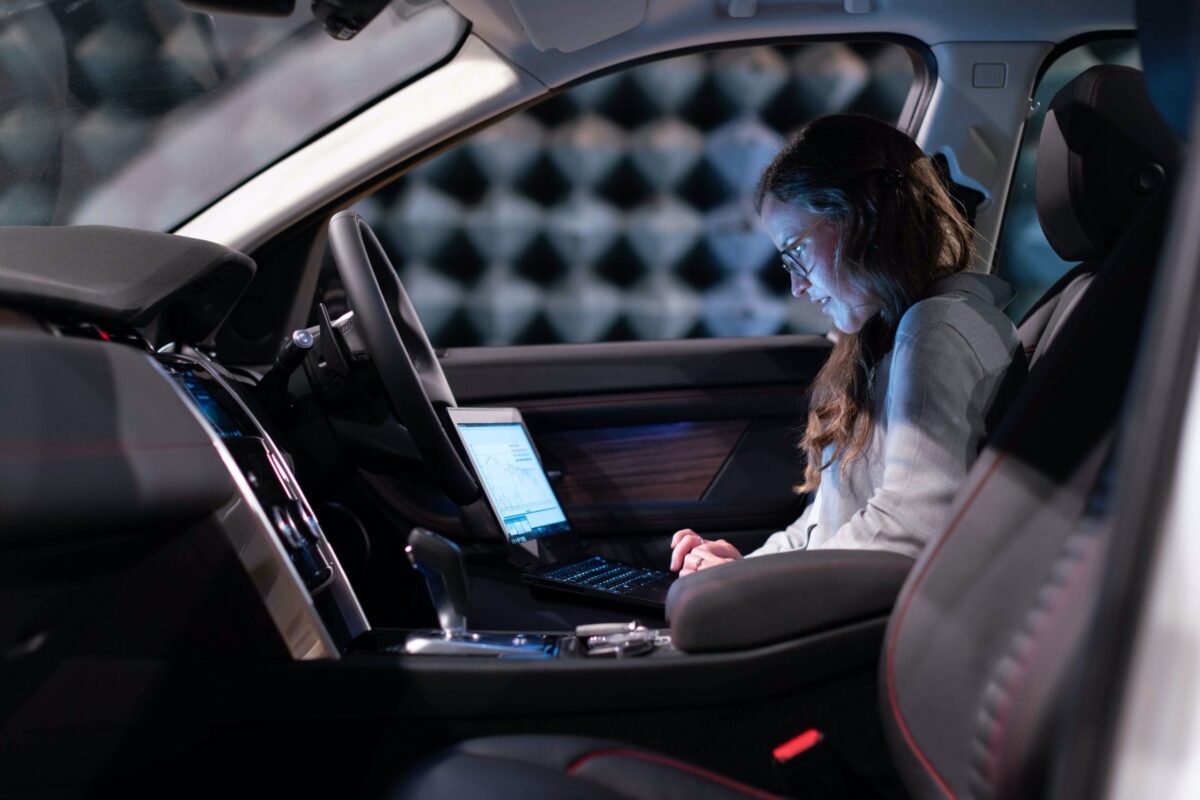

As shoppers increasingly interact with machines instead of people, there are huge ramifications for the way we think about sales interactions (in stores, call centers, etc.) and communications strategies.
Please read my Forbes article.


As shoppers increasingly interact with machines instead of people, there are huge ramifications for the way we think about sales interactions (in stores, call centers, etc.) and communications strategies.
Please read my Forbes article.


These days, seemingly everyone is applying Artificial Intelligence (AI) and machine learning. I have written about disruptions in the manufacturing industry, such as Industry 4.0, while illustrating the Hard Trends that indicate where improvements will be made in the future.
The construction industry, which makes up 7% of the global workforce, should already have applied these technologies to improve productivity and revolutionize the industry. However, it has actually progressed quite slowly.
Growth in the construction industry has only been 1% over a few decades while manufacturing is growing at a rate of 3.6%. With the total worker output in construction at a standstill, it is no surprise that the areas where machine learning and AI could improve such statistics were minimal. Yet, those technologies are finally starting to emerge in the industry.
Artificial Intelligence (AI) is when a computer mimics specific attributes of human cognitive function, while machine learning gives the computer the ability to learn from data, as opposed to being specifically programmed by a human. Here are ten ways that AI and machine learning will transform the construction and engineering industries into what we’ll call “smart construction.”
Even efficient construction teams are plagued by cost overruns on larger-scale projects. AI can utilize machine learning to better schedule realistic timelines from the start, learning from data such as project or contract type, and implement elements of real-time training in order to enhance skills and improve team leadership.
When a building is constructed, the sequence of architectural, engineering, mechanical, electrical, and plumbing tasks must be accounted for in order to prevent these specific teams from stepping out of sequence or clashing. Generative design is accomplished through a process called “building information modeling.” Construction companies can utilize generative design to plot out alternative designs and processes, preventing rework.
The construction process involves risk, including quality and safety risks. AI machine learning programs process large amounts of data, including the size of the project, to identify the size of each risk and help the project team pay closer attention to bigger risk factors.
A recent startup utilized 3D scanning, AI and neural networks to scan a project site and determine the progress of specific sub-projects in order to prevent late and over-budget work. This approach allowed management to jump in and solve problems before they got out of control. Similarly, “reinforcement learning” (machine learning based on trial and error) can help to collate small issues and improve the preparation phase of project planning.
Professionals often fear machines will replace them. While intelligent machines will take over first repetitive and eventually more cognitively complex positions, this does not mean a lack of jobs for people. Instead, workers will transition to new, more fulfilling and highly productive roles to save time and stay on budget, and AI will monitor human productivity on job sites to provide real-time guidance on improving each operation.
Manual labor not only has the potential to be taxing on the body, but also to be incredibly dangerous. Presently, a general contractor is developing an algorithm that analyzes safety hazards seen in imagery taken from a job site, making it possible to hold safety briefings to eliminate elevated danger and improve overall safety on construction sites.
AI and machine learning have the capacity to plot out accurate distribution of labor and machinery across different job sites, again preventing budget overruns. One evaluation might reveal where a construction site has adequate coverage while another reveals where it is short staffed, thereby allowing for an efficient and cost-effective repositioning of workers.
When structures can be partially assembled off-site and then completed on-site, construction goes faster. The concept of using advanced robots and AI to accomplish this remote assembly is new. Assembly line production of something like a wall can be completed while the human workforce focuses on the finish work.
The data gathered from construction sites and the digital lessons learned by AI and advanced machines are all tools for improving the productivity of the next project. In this way, each construction site can contribute to a virtual textbook of information helpful to the entire industry.
Structures are always settling and shifting slightly. It would be beneficial to be able to dive back into data collated by a computer to track in real time the changes and potential problems faced by a structure — and AI and machine learning make this possible.
Given the inevitable changes on the horizon, and the potential for costs to drop up to 20% or more with increased productivity, professionals in the construction industry must pay attention to Hard Trends, become more anticipatory, and ultimately learn to turn disruption and change into opportunity and advantage.
Discover proven strategies to accelerate innovation with my latest book The Anticipatory Organization. Follow this link for a special offer.
Shape the Future–Before Someone Else Does It For You!


Across my 40-year career in technology, I have increasingly heard clients and others express to me their greatest fear, which is that they are not “keeping up” with technology. 20 years ago, I would hear that worry expressed a few times a year. Now I hear it a few times a week.
Honestly, at first I wrote it off. I thought that it was just a few Luddites who didn’t want to put in the effort to stay with the pace of change. But then I started to experience that feeling myself, so it became personal. And uncomfortable. I wasn’t “keeping up.”
And, it wasn’t just a feeling. It couldn’t be explained away that I felt like I wasn’t keeping up, but in actuality, I was doing just fine. No, I was convinced that I was in fact not keeping up. Technology was passing me by. And it started feeling worse than uncomfortable. It started to feel downright scary, because my business was about technology. I started thinking about how I rarely saw any 50-year-old programmers. And I started hearing about how venture capitalists would pour millions into a company founded by a 20-year-old, while companies were laying off middle-aged technologists left and right.
No, this wasn’t my imagination. There was a popular perception out their that technology was a young person’s game, and that most people can’t keep up. And the older you get, the more it’s true.
So, I started thinking about this attitude, and I began to realize that it doesn’t actually make any sense to try to “keep up” with technology. No one tries to “keep up” with a car or an airplane. People can’t do what those technologies do. You don’t need to keep up with them–you need to ride them. Technology is a tool that makes you better, not something you need to outdo, like some kind of modern-day John Henry hammering spikes.
That change in attitude changed the way I approached my job. I no longer cared whether I kept up with all the changes. I just focused on a constant search for tools–things that multiplied my effectiveness, making me better. When I found them, I rode them. And I ignored everything else, reasoning that if whatever I was currently ignoring in fact turned out to be important, then they would be brought to my attention again soon enough, and I could ride them then.
That change in focus also changed who I thought I was. In my first few years as a digital marketing consultant, I was named to a couple of lists as one of the “100 Best Internet Marketers” or some such monicker. And then they stopped naming me, which should have been upsetting, but it wasn’t, because my focus had changed.
I no longer wanted to play the game of keeping up and proving that I was keeping up by speaking on every new development or coming out with a new book that “explained everything you need to know” about some new development. Instead, I wanted to find the most important things to ride and teach my clients how to ride them, too. It was at that point that I changed my focus from consulting to software. Instead of manually analyzing problems and telling clients what to do, I started to develop techniques that automatically collected data and analyzed it, eventually using Artificial Intelligence techniques, because AI was the best technology to ride for the problems that I am trying to solve.
And I don’t worry whether I am keeping up with 5G or IoT or blockchain. They might be very important technologies for me to ride someday, but, for the moment, I am ignoring them, because I don’t judge them to be important technologies to ride in pursuit of the problems I am solving. At some point, I might change my mind because i can see how useful they are for the problems I am trying to solve then. And you know what? They will still be there waiting for me.
The truth is that human beings didn’t evolve at the pace that technology evolves, so none of us are designed to keep up. But the entire history of humans show that we invent tools to solve problems, and if you treat everything in technology as a tool that you should evaluate to see if it is interesting as a solution to a problem you have, suddenly it stops being scary and starts being fun.
I hope you go out and have fun with technology. Go for a ride.


Plenty has been written about how AI gets smarter with experience, the way people do. If you perform a task 100 times, you are faster and better at that task the 100th time than the first time–and AI models have that same quality. The more experience they have (usually expressed as the more data they have seen), the more patterns the models can recognize to make better sense of each new thing they see. I do a lot of work with AI models around website customer experience–often focused on how web users search and navigate company websites. The AI models reveal insights of where web users get stuck, or, more happily, which content seems to answer their needs.
That’s very powerful, but even more powerful is connecting AI models to automated actions. You see, if all the models do is to provide better insight to humans, those models are useful, but they will always be gated by the time and cost of humans taking actions on those insights. I have heard clients express to me in frustration that “the last thing [they] need is another dashboard”–even a smarter one populated with keen AI insights, because it still leaves them with more and more manual improvements to make.
My recent work with SoloSegment [full disclosure: I am a Senior Strategist and partner with SoloSegment] has opened my eyes to how AI can lead to immediate and continuous improvement of a website. You can use behavioral data to make searches on the site more successful. You can recommend content based on what has worked for others in the past. In other words, your website becomes more autonomous–a living, self-improving entity–that gets better the more people use it.
None of this means that you don’t need people to do the vast majority of the tasks of creating content, improving design, and all the rest of the things we do for our websites. But, for the first time, there are some things that humans don’t need to do, because the AI models, coupled with automated actions, can make some of the improvements in hands-free fashion. I don’t know about you, but this feels like a breakthrough to me, where we finally have linked the intelligence of the models to quickly and automatically improving the customer’s experience. And I can’t help but think there is much more to come.


Artificial intelligence (A.I.) is a technological advance for humankind that has some people excited and others terrified of what is to come. The main concern is rooted in what A.I. will do to jobs, and how we as human beings will be affected by changes in digital and mechanical techniques.
A.I. and other new forms of autonomous machine function are in the process of transforming our personal and professional lives, and this represents a Hard Trend that will happen and a subject I’ve discussed for decades now. We are just starting to see some incredible progression in the A.I. space, giving us a chance to pre-solve problems involved in real-world applications of A.I.
But while function is one thing, the newfound transformation we’ve watched come to fruition is coming from machine learning, a subset of A.I. that enables machines to become better at tasks that were previously dependent on human intelligence. With advances in a machine’s capability to think and learn like people, it’s easier than ever to pre-program physical functions so A.I. can take over menial or mundane tasks. Take, for example, a study conducted by legal tech startup LawGeex, which challenged 20 experienced lawyers to test their skills and knowledge against an A.I.-powered system the company built.
A lawyer is not often considered replaceable by technology or artificial intelligence. In this challenge, the task was to review risks contained in five nondisclosure agreements — a simple undertaking given the group of legal professionals, which included associates and in-house lawyers from Goldman Sachs, Cisco, and Alston & Bird, as well as general counsel and sole practitioners. This lineup should easily have triumphed over an A.I.-powered algorithm, right?
As a matter of fact, the study revealed that the A.I. system actually matched the top-performing lawyer for accuracy, as both achieved 94%. As a group, the lawyers managed an average of 85%, with the worst performer scoring a 67%.
But what about the speed of those decisions? When reviewing the nondisclosure agreements, the A.I. system far outpaced the group, taking just 26 seconds to review all five documents, compared to the lawyers’ average speed of 92 minutes. That is a tremendous spread when compared to the near-perfect accuracy the algorithm performed at in that time! The fastest review time of a single lawyer in the group was 51 minutes — over 100 times slower than the A.I. system! And the slowest time was nearly a standstill pace, as it clocked in at 156 minutes.
While reviewing documents is just one of several parts of the job of a lawyer, this data further proves the Hard Trend that I implore everyone to pay attention to in the years to come. Artificial intelligence is here to stay, and by using machine learning and deep learning techniques, new A.I. systems are learning how to think better and better every day. So the question remains: Are you anticipating how A.I. can be used to automate tasks and do things that might seem impossible today — in other words, disrupt your industry? Are you starting to learn more about A.I. so that you can become a positive disruptor rather than become the disrupted?
For now, according to consultants, the fact remains that 23% of legal work can be easily performed using artificial intelligence; however, there are many aspects of a lawyer’s job, the obvious example being providing an emotional and compelling closing argument in court, that are currently beyond the capabilities of algorithms. While that may be the case today, what’s next? Using methods that I discuss in my latest book, The Anticipatory Organization, you can learn how to become an anticipatory thinker and be more entrepreneurial in the ways you apply A.I. technology to your profession.
Take the example of Alexa, which is utilized in an ever-growing number of applications, from ordering groceries to playing our favorite song during dinnertime. This device, enabled by A.I., has learned our routines and how to serve us better each day by listening to us ask it questions or give it tasks to accomplish.
Netflix and Spotify media streaming services are using A.I. to learn what we like to listen to or watch, and then, using this knowledge combined with their own databases, they can quickly suggest other songs or shows we may also enjoy. Over time they increasingly learn to understand the dynamics of what we like, recognizing our patterns enough to suggest new things to us we will most likely enjoy — very much like a best friend would introduce us to a new music group.
These are just two examples of many A.I.-enabled services that have been integrated into our lives, yet it was not too long ago that applications like these would have been viewed as an impossibility. In a relatively short amount of time they have become second nature in our lives. If A.I. can quickly accomplish a lawyer’s task today, then it can also learn how to accomplish many tasks in industries once thought untouchable by automation and machine learning, such as medicine, finance and design.
As an entrepreneur, it is increasingly important to understand what A.I. can do to create business value. A.I. is presently forecast to reach nearly $4 trillion by 2022. Reacting to this opportunity will only keep you behind and disrupted. It’s time to learn to become anticipatory leaders in our fields, solving problems before they happen, and elevating our thinking to actively shape a positive future for ourselves and others.
If you would like to learn more about how you can better anticipate transformation in the professional world and developments in artificial intelligence, then be sure to pick up my latest book, The Anticipatory Organization. Let me help you take your career to the next level and remain indispensable in an ever-changing technological frontier.


One of the biggest news subjects in the past few years has been artificial intelligence. We have read about how Google’s DeepMind beat the world’s best player at Go, which is thought of as the most complex game humans have created; witnessed how IBM’s Watson beat humans in a debate; and taken part in a wide-ranging discussion of how A.I. applications will replace most of today’s human jobs in the years ahead.
Way back in 1983, I identified A.I. as one of 20 exponential technologies that would increasingly drive economic growth for decades to come. Early rule-based A.I. applications were used by financial institutions for loan applications, but once the exponential growth of processing power reached an A.I. tipping point, and we all started using the Internet and social media, A.I. had enough power and data (the fuel of A.I.) to enable smartphones, chatbots, autonomous vehicles and far more.
As I advise the leadership of many leading companies, governments and institutions around the world, I have found we all have different definitions of and understandings about A.I., machine learning and other related topics. If we don’t have common definitions for and understanding of what we are talking about, it’s likely we will create an increasing number of problems going forward. With that in mind, I will try to add some clarity to this complex subject.
Artificial intelligence applies to computing systems designed to perform tasks usually reserved for human intelligence using logic, if-then rules, decision trees and machine learning to recognize patterns from vast amounts of data, provide insights, predict outcomes and make complex decisions. A.I. can be applied to pattern recognition, object classification, language translation, data translation, logistical modeling and predictive modeling, to name a few. It’s important to understand that all A.I. relies on vast amounts of quality data and advanced analytics technology. The quality of the data used will determine the reliability of the A.I. output.
Machine learning is a subset of A.I. that utilizes advanced statistical techniques to enable computing systems to improve at tasks with experience over time. Chatbots like Amazon’s Alexa, Apple’s Siri, or any of the others from companies like Google and Microsoft all get better every year thanks to all of the use we give them and the machine learning that takes place in the background.
Deep learning is a subset of machine learning that uses advanced algorithms to enable an A.I. system to train itself to perform tasks by exposing multi-layered neural networks to vast amounts of data, then using what has been learned to recognize new patterns contained in the data. Learning can be Human Supervised Learning, Unsupervised Learning and/or Reinforcement Learning like Google used with DeepMind to learn how to beat humans at the complex game Go. Reinforcement learning will drive some of the biggest breakthroughs.
Autonomous computing uses advanced A.I. tools such as deep learning to enable systems to be self-governing and capable of acting according to situational data without human command. A.I. autonomy includes perception, high-speed analytics, machine-to-machine communications and movement. For example, autonomous vehicles use all of these in real time to successfully pilot a vehicle without a human driver.
Augmented thinking: Over the next five years and beyond, A.I. will become increasingly embedded at the chip level into objects, processes, products and services, and humans will augment their personal problem-solving and decision-making abilities with the insights A.I. provides to get to a better answer faster.
A.I. advances represent a Hard Trend that will happen and continue to unfold in the years ahead. The benefits of A.I. are too big to ignore and include:
Technology is not good or evil, it is how we as humans apply it. Since we can’t stop the increasing power of A.I., I want us to direct its future, putting it to the best possible use for humans. Yes, A.I. — like all technology — will take the place of many current jobs. But A.I. will also create many jobs if we are willing to learn new things. There is an old saying “You can’t teach an old dog new tricks.” With that said, it’s a good thing we aren’t dogs!
Start off The New Year by Anticipating disruption and change by reading my latest book The Anticipatory Organization. Click here to claim your copy!


I am working with large companies on their use of Artificial Intelligence all the time, and it is possibly the most polarizing technology I have ever been involved with. Some people believe that AI will give us all a life of leisure, with machines doing more of the work so we don’t need to slave away for 40 hours a week. Others are spooked because they think that AI is coming for our jobs. What seems hard for each of those groups is that they are both essentially projecting the same thing–it’s just a question of whether they are optimistic or pessimistic personalities.
I see the same thing with my own clients–AI is equally polarizing, but this time it is around its effectiveness. Some are AI skeptics, talking about how the technology is over-hyped. Others believe it is magic, and will buy anything with those two magic letters. Both views are right–and wrong. AI just isn’t very simple.
Businesses should always be looking to improve their return on investment, which means choosing the simplest technique that solves the problem. Sometimes that’s AI, but often it’s something simpler, cheaper, and lower risk, so we should start there. Many folks are surprised when I say that, because they expect me to be pushing AI for everything, but I don’t see how that makes any sense. I spoke with a potential new client who was so taken aback that as we were leaving, they said to us, “Gee, we speak to a lot of vendors, but thanks for surprising us.”
If you are listening to vendors blathering on about that 5G blockchain kind of AI, it’s time to stop listening to buzzwords and start looking for competence. If it sounds too good to be true, it is. If your spidey sense starts to tingle every time they start talking about neural networks, listen to that inner voice. AI is no different from every other kind of approach out there. Used appropriately, it can be a huge benefit to your business. But you should be asking questions if your vendors wave their hands and can’t really explain why AI is needed and exactly why it works better. Don’t pay surge pricing for the flavor of the month.


I keep reading scare-mongering over how AI is going to make everyone unemployed. Some others say that it will give us a life of leisure. Maybe we should all stop to realize that both are saying the same thing–we are just learning who are optimists vs. pessimists.
But both of these points of view gloss over the real truth–AI doesn’t eliminate very many jobs completely. Yes, if self-driving cars come to pass, Uber drivers and truck drivers are at risk. But no matter how much automation is applied to Quickbooks, we will still need accountants–they just might not be entering and analyzing the transactions anymore.
The reason for that is that what we have today is called Narrow AI–it can be better than humans at discrete tasks, such as chess or Go or Jeopardy. It can make predictions within small spheres. But we are nowhere near General AI, where the judgement of a human across many spheres is possible. Humans need to be guiding all automation, especially AI, for the foreseeable future. So, while there will be some jobs that get largely automated away, we will likely still need humans to do parts of those jobs and there will likely be new jobs created we don’t even dream of yet.
In 1790, 90% of the US workforce were farmers. 200 years later, in 1990, less than three percent remained on the farm, yet we didn’t experience 87% unemployment. And that doesn’t even take into account the massive growth in population or the major expansion in the workforce as women joined.
No one knows what will happen in our AI future, but you can expect that it won’t be as bad as people fear nor as great as they expect. After all, if I had told you 20 years ago that you would willingly carry around a device 24×7 that allows your boss to call you any time of the day or night and know that you could be reached, you’d have labeled me a nutjob.
But we all carry our cell phones religiously and would fight to keep them if pressed. So, we are often better at seeing the downside of new technology than the upside and we should imagine that AI will probably turn out the same way.


By Daniel Burrus and Neil Smith
(In this blog series on how elevating cognitive performance is a game changer for organizations, I’ve invited Neil Smith, CTO at Think Outcomes, to join me in writing on this important topic due to his expertise and the cognitive performance software his firm has created.)
AI and cognitive computing have grabbed headlines. Yet, anticipatory leaders know that the elevation of cognitive performance among teams is key to maximize results. Leaders need to help their teams of professionals improve how they envision opportunities, manage downside risks and achieve greater results. Cognitive computing has to do more than deliver data-driven insights to their minds. It must help teams shape outcomes, act on implications and professionalize role-based, cerebral processes in the form of software processes. That’s where cognitive performance is front and center.
Cognitive performance involves how well professionals perform their cognitive work. Specifically, how they:
They perform these cerebral activities with their thoughts and their communications. These mini processes in their minds are nondeterministic and lead to decisions within organizations. As machine learning and deep learning move into organizations, professionals who want to increase their cognitive performance must step up their game at the same time. They must center their attention on addressing uncertainties and advance their abilities to identify and create greater certainty. In doing so, they must raise their levels of quality in decision-making processes and stakeholder communication processes that take place in their minds. Their stakeholders, customers, suppliers, employees and their industries depend on it. The status quo of gut-based decision making and misunderstandings among viewpoints leads to operational inefficiencies and monetary waste in downstream activities.
Change is accelerating in business, which creates more uncertainties that find their way into enterprises across all functional responsibilities — in strategies, integration, operations, supply chains, human resources, research, engineering, finance, process management, product management and consulting, to name a few. Today, cognitive performance is based on role-based experience, learning, frequency, recency and luck — all of which vary from role to role and person to person.
The cognitive activities in the minds of professionals are ripe for optimization. Optimization is possible by learning anticipatory skills and applying cognitive performance technologies.
The human mind is limited when it is engaged to:
Although these are human limitations, the mind is extendable through the use of computing, which does a very good job of augmenting the mind for these activities. In today’s era of cognitive computing, the human mind can benefit from a digital extension to achieve the cognitive capabilities it cannot — and does not — realize on its own.
At work, professionals who think for a living formulate how to execute their work in their minds. They’ve built their cognitive expertise over time through on-the-job experiences and homegrown cerebral processes.
 Before transactional software systems codified the operating processes of transactional work into the business infrastructure – i.e., ERP, SCM and CRM processes – organizations created homegrown processes and systems to manage their transactional operations. ERP, SCM and CRM systems optimized task-oriented processes before, during and after a customer transaction within organizations, in supply chains and in demand chains. As a result, the transactional side of the operating model has become relatively frictionless.
Before transactional software systems codified the operating processes of transactional work into the business infrastructure – i.e., ERP, SCM and CRM processes – organizations created homegrown processes and systems to manage their transactional operations. ERP, SCM and CRM systems optimized task-oriented processes before, during and after a customer transaction within organizations, in supply chains and in demand chains. As a result, the transactional side of the operating model has become relatively frictionless.
Today’s friction exists within the minds of professionals on the cognitive side of the operating model. A key to future success is to eliminate this friction. That’s where anticipatory skills, combined with cognitive performance software, comes into play.
Learn how to elevate your planning, accelerate innovation and transform results with The Anticipatory Learning System and how to maximize the cognitive performance of your team with Cognitive Performance Software.


I have spent the last 40 years on the cusp of various technologies. (It’s a trick. If you are on the cutting edge, there are no experts, so you get to call yourself one.) Now I am an expert in Marketing and AI. (See what I did there?)
I actually have been working in text analytics since the 80s and was first exposed to machine learning in IBM Research in the 90s, so I have been doing this for a while, if that counts for anything. So I am used to hearing people talk about how AI is the future. And it is.
Sometimes, it’s just how you talk about it. I remember early in my career, I did what I thought was a knockout presentation on some new superpower technology, and as the audience was filing out, a few people came up to speak to me afterwards. They were all very excited and all agreed as one person breathlessly said to me, “Wow, you are really a visionary.”
Except that’s bad. Because that means that they didn’t think they needed to do anything about that technology for three years. So if every time you hear about machine learning it sounds to you like Big Data 5G Blockchain, then you are missing the power of the present.
Machine learning can take the data you are sitting on and start predicting outcomes that you needed to wait to have happen. We are working with clients to predict the bounce rates of new pages without having to wait three months to see what they are. You can imagine applying the same approach to exit rate, social shares, inbound links, and any other content metric.
Think about what an advantage that is. Rather than suffering with poorly-performing pages for months until the data stabilizes, you can make changes presuming that those pages will perform the way similar pages have in the past. So make them look like better-performing pages instead. But do it now, not months from now.
That is what machine learning does. It takes all the data that you already have and speeds up the correct decision. That speed is your competitive advantage. Or at least it is your competitive advantage if you are using machine learning now. Conversely, if you think AI is the future, then it might be your competitor’s advantage now.